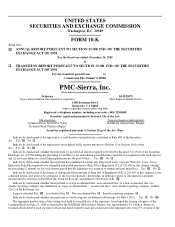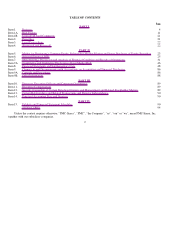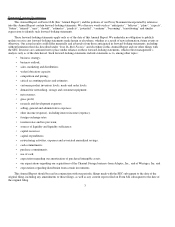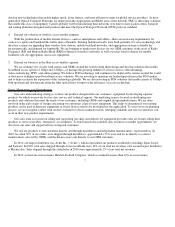Adaptec 2010 Annual Report Download - page 11
Download and view the complete annual report
Please find page 11 of the 2010 Adaptec annual report below. You can navigate through the pages in the report by either clicking on the pages listed below, or by using the keyword search tool below to find specific information within the annual report.
OEMs are becoming more price conscious as semiconductors sourced from third party suppliers start to comprise a larger
portion of the total materials cost in OEM equipment. This price sensitivity from our customers can lead to aggressive price
competition by competing suppliers that may force us to decrease our prices to win a design and therefore decrease our gross profit.
OEMs also consider the quality of the supplier when determining which component to include in a design. Many of our
customers will consider the breadth and depth of the supplier’s technology, as using one supplier for a broad range of technologies
can often simplify and accelerate the design of next generation equipment. OEMs will also consider a supplier’s design execution
reputation, as many OEMs design their next generation equipment concurrently with the semiconductor component design. OEMs
also consider whether a supplier has been pre-qualified, as this ensures that components made by that supplier will meet the OEM’s
quality standards.
We compete against established peer-group semiconductor companies that focus on the communications and storage
semiconductor business. These companies include the following: Altera Corp., Applied Micro Circuits Corp.; Broadcom Corp.;
Cortina Systems, Inc.; Emulex Corp.; Exar Corp.; Infineon Technologies AG; Intel Corp.; LSI Corp.; Maxim Integrated Products,
Inc.; Marvell Technology Group Ltd.; Mindspeed Technologies, Inc.; QLogic Corp.; Vitesse Semiconductor; and Xilinx, Inc.. Many
of these companies are well financed, have significant communications semiconductor technology assets and established sales
channels, and depend on the market in which we participate for the bulk of their revenues.
Over the next few years, it is possible for additional competitors to enter the market with new products, some of which may also
have greater financial and other resources than we do.
We are also continuing to expand into certain market segments, such as the Enterprise Storage market segment that have
established incumbents with substantial financial and other resources. Some of these incumbents derive a majority of their earnings
from these markets. We expect continued strong competition in these markets.
L
ICENSES
, P
ATENTS
AND
T
RADEMARKS
We rely in part on patents to protect our intellectual property and have a total of 530 U.S. and 87 foreign patents for circuit
designs and other innovations used in the design and architecture of our products. In addition, we have 95 patent applications pending
in the U.S. Patent and Trademark office. Our patents typically expire 20 years from the patent application date, with our existing
patents expiring between 2011 and 2030.
We do not consider our business to be materially dependent upon any one patent. We believe that a strong portfolio of patents
combined with other factors such as our ability to innovate, technological expertise and the experience of our personnel are important
to compete effectively in our industry. Our patent portfolio also provides the flexibility to negotiate or cross license intellectual
property with other semiconductor companies to broaden the features in our products.
We also rely on mask work protection, trademarks, copyrights, trade secret laws, employee and third-party nondisclosure
agreements, and licensing arrangements to protect our intellectual property.
PMC, PMC-Sierra and our logo are registered trademarks and service marks. We own other trademarks and service marks not
appearing in this Annual Report. Any other trademarks used in this Annual Report are owned by other entities.
10
•
interfaces easil
y
with other com
p
onents in the
p
roduct;
•
meets
p
ower usa
g
e re
q
uirements;
•
is
p
riced com
p
etitivel
y
; and
•
is commerciall
y
available on a timel
y
basis.
























